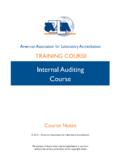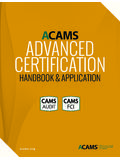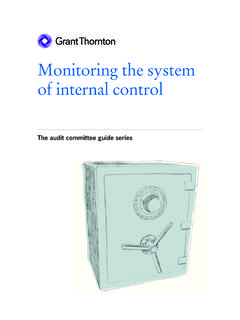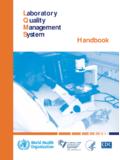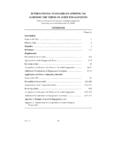Transcription of Handbook on Bank Branch Audit - iThejas Solutions
1 IHandbook onBankBranch AuditCA Handbook is neither a technical publication on Audit nor a technical publication on banking. It is an exercise in compilation of the various issues which the author has come across in the course of professional engagement and interactions with the members of this esteemed profession. The readers and users of this book are requested to look into the relevant Statements, Standards and Technical Publications issued by The Institute of Chartered Accountants of India regarding Auditing and the Reserve bank of India for guidelines relating to banking, including circulars, notifications and other directives to banks to comply with the requirements of the Banking Regulation Act, author while trying to reach out to the users by elucidating practical illustrations, specifically states that they are his personal and individual views and hence requests the users to form their own views and opinions on situations similar to those illustrated and will not be responsible for any act or omission which may arise for any person who uses this publication.
2 Or any consequence author specifically recognises that some portion of the materials issued by the Reserve bank of India in terms of its master circular on Income Recognition, Asset Classification and Provisioning have been reproduced in full or part, as they are in public domain for all stake holders to understand, familiarise and comply with the norms and some portion of the Standards on Auditing issued by the Institute of Chartered Accountants of India have been referenced, cited or illustrations and views expressed by the author are his proprietary material. This book is meant for exclusive use of the members of the profession of Chartered Accountancy for their purposes as an aid in addition and not in substitution to the technical publications and Reserve bank directives. It is not meant to be used for any presentation, distribution, marketing or commercial exploitation, except with the written permission of the by : Sri Balaji Publishers, , Gokul, I Stage, II Cross, 10th Main, II Phase, Bangalore 560054, Mobie : 91 9035672456 Email : by : Sumukha Technologies No.
3 82/2, 2nd Floor, Magadi Road, Bangalore - 40 Email : : Branch Audit , is one of the most important assignment in a practising Chartered Accountants yearly calendar, more than 90% of those in practice are involved in this annual exercise, thus it speaks volumes for its this book an attempt is made to cover the practical aspects involved in the Audit of bank branches, which I hope will be found useful to the readers / users of this Sudha Suresh has been a constant source of motivation and always encouraged me in my professional endeavours. My partner, CA K. Anand, has been a pillar of strength for me and has encouraged me to author this book. It was in March 2005, CA Rajgopal and CA Shivamohan called me, at the recommendation of CA H. Anil Kumar to be a resource person for the bank Audit Seminar at Udupi. Just three months prior to that, the first stokes were ignited by CA S. Venkataramani, who chided me saying that I am wasting my ability, being in the back stage and should move forward as a speaker, I had then promised him that, I will become a resource person shortly and thus began my role as a Speaker on bank Branch audits.
4 Starting at Udupi Branch at the behest of CA Devanand, in the past 7 years, most of the branches in the Southern Region have given me an opportunity to deliver lectures on bank Audit . What started off with practical issues on Audit of advances, moved over to areas other than advances, walk-through of a bank Branch Audit , accounting standards in bank Branch Audit etc. Not to be left behind are the CPE Chapters in Bangalore, Davangere and Gulburga whose invitations motivated me to reach out to their members. In the journey of being a resource person, I have fine tuned my understanding of the subject, sharpened my skill sets with the interactive sessions and quick fire questions of the members of this learned profession, enabling me to become better informed and more came CA Anant Mutalik, President of KSCAA, asking me to pen this Handbook on bank Branch Audit , and I readily agreed. Shri. S. Muralidharan combined his more than 3 decades of experience as a banker, by meticulously combing through the material and providing valuable suggestions.
5 The invaluable inputs given by CA Allama Prabhu ,and CA S. Pattabiram deserve special particularly wish to place on record my deep sense of appreciation and gratitude to CA Prabhudev S. Aradhya and his Senior CA Shivarama Prasad, CA R Sundararajan, CA D Venkataraman and CA A. V. Pal who permitted me with materials to use in this book and CA Gulecha for his contributions. I am indebted to CA Ethirajan whose mentoring, has enabled me to be what I am today. As far as bank Audit , it is the baby steps carefully taught to me by Shri. M. Balasubramaniam, pouring over the records of a Branch for 3 weeks continuously which fascinated me to take interest on this subject matter in thank M/s. Indian bank and M/s. Lakshmi Vilas bank for their contributions, M/s. Sumukha Technologies and M/s. Paramount Colour Graphics for burning midnight oil to bring this book on time. I also thank all other who have contributed directly and indirectly.
6 Lastly, I do believe to err is human , therefore I will be grateful to those who will be kind enough to give me their feedback and point out error(s), if any, that may have unknowingly crept in while authoring this Handbook . Place : Bangalore CA SureshivForewordCA. Reserve bank of India, the country s Central bank , has the exclusive power of granting license for banking, and through that power it directs and oversees the operations of banks. Banking is a unique intermediation function where public money is collected and lent (channelised) for productive sectors of the economy. An Audit of such business has as its first requisite the Knowledge of the Business . Audit functions are circumscribed by specific standards of which Knowledge of Business is one (AAS 20). Second, the directions of RBI are contained in a series of circulars concerning the various aspects of operations - accounting and reporting that covers both internal and external controls.
7 This requires that the auditor is aware of all the relevant circulars. Third, every Audit requires a plan - macro approach and Audit Programme - micro details of verification, evidence, materiality, analytical procedure, sampling, additional consideration for special items and documentation of such plan and programme, keeping the working papers open to peer review. Lucidly written and practically sequenced the book covers several of these aspects and is a hands-on guide to a practicing CA. Fourth, the LFAR and annexure lay down the minute Audit reporting process. LFAR has as its object a focus on systematic issues and is a lead to the structure of Plan and Programme. Fifth, the type of evidence required in banking envisages basic understanding of several connected legislations and assessment of the powers of bank authorities. The learned author refers to specific issues on reporting and also looks at tax Audit report requirements.
8 A bank that does mostly intermediation function can never be in the red. Its accountability for public funds comprising of capital adequacy sound asset-liability management, provision for generated toxic assets called NPAs, statutorily prescribed asset classification, avoidance of greening or camouflage of any variety , income recognition, have over the years been caught by the RBI s inspection lens revealing scams. For non-recurrence, RBI has dexterously woven its various directions into the texture and tapestry of controls. The author s experience and competence, evident in the book, help the readers in coping with special skills, covers comprehensively compliance with the RBI directions, cogently sequences and explains the verification steps, collects Audit standards on planning, documentation, programming, quality control, representation from management, clinically examines the contents and issues of reporting through LFAR, portraying as it does the critical role the members of our profession play in this important statutory function.
9 My congratulations to the author and commendations to the S. KrishnaswamyvInDEx Chapter Page no1. Role of banks in Indian economic History of bank audits (including Branch audits) Role played by the members of the Future of bank Branch audits Expectations of stakeholders from members123452. Gist of RBI Master Circular on Income Recognition, Asset Classification and Provisioning Asset Classification Guidelines for classification of assets Provisioning norms General principles and prudential norms for restructured advances Special regulatory treatment for asset classification9101619223. Branch Audit - Scope, Plan, Program and Standards Balance sheet Audit Compliance with quality control standards Audit plan and methodology Audit program Audit documentation Representations from management Application of accounting standards Practical approach to bank Branch audit2426283032333437vi4.
10 Practical Issues in Audit of Financial Areas other than Other practical issues In CBS environment40427477785. Long Form Audit Reports special focus areas Long Form Audit Report or LFAR LFAR for specialised Branches Special Consideration in LFAR, Tax Audit and Certifications Summary of frequent observations by bank Branch auditors in LFAR Tips to carry out an effective and speedy Branch Audit of Bank79858587876. Specific aspects in Tax Audits887. Asset Liability Jilani committee and Ghosh Capital adequacy PMRY / SLR / CRR 12 odd dates Compliance with RBI Norms on DICGC / ECGC Interest subvention TUF schemes Previous year MOC Certification of Provision for Restructured Certificate of Sensitive Sector and CRE 888990919191929292939393vii8. Audit Closure, Documentation and Discussion with management and Methodology for preparing Arriving at an Qualification in the Main Working papers94959596969.
